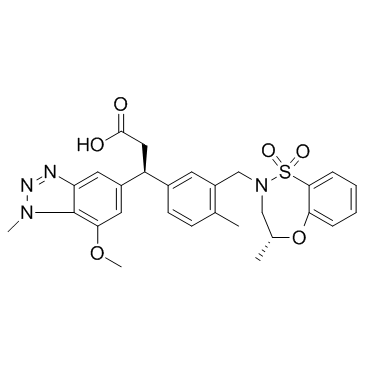KI696 |
| Catalog No.GC31321 |
KI696 is a high affinity probe that disrupts the Keap1/NRF2 interaction.
Products are for research use only. Not for human use. We do not sell to patients.

Cas No.: 1799974-70-1
Sample solution is provided at 25 µL, 10mM.
KI696 is a high affinity probe that disrupts the Keap1/NRF2 interaction.
KI696 (compound 7) exhibits very high affinity for the KEAP1 Kelch domain (ITC Kd=1.3 nM with the exception of the organic anion transporting polypeptide 1B1 (OATP1B1) (IC50=2.5 µM), the bile salt export pump BSEP (IC50=4.0 µM), and the phosphodiesterase PDE3A (IC50=10 µM), no significant cross-reactivity is observed. No cytotoxicity is observed towards BEAS-2B cells with KI696 at concentrations up to 10 µM. KI696 increases NRF2 Nuclear Translocation in Normal Human Bronchial Epithelial cells. KI696 increases mRNA expression of the NRF2-dependent genes NQO1 and GCLM in NHBE cells transfected with the non-targeting siRNA, while NRF2 gene silencing significantly decreases compound activity. KI696 increases NQO1 Activity in an NRF2-Dependent Manner. Treatment with tBHP clearly has a detrimental effect on cell health and appearance while pre-treatment of cells with 1 µM KI696 before the exposure to tBHP maintained cell morphology consistent with the DMSO control. KI696 Induces the Expression of NRF2-Regulated Genes in COPD patient-derived bronchial epithelial cells[1].
KI696 induces the expression of each of the Nqo1, Ho-1, Txnrd1, Srxn1, Gsta3, Gclc genes in a dose-dependent manner, with maximum increases over vehicle controls of 37-(Nqo1), 17-(Ho-1), 9-(Txnrd1), 28-(Srxn1), 15-(Gsta3) and 13-fold (Gclc) occurring at the 50 µmol/kg dose. EC50 values are 44.0, 25.7, 42.6, 33.8, 28.4, and 44.1 µmol/kg, respectively, giving an average EC50 value of 36.4±3.4 µmol/kg. KI696 attenuates ozone-Induced pulmonary inflammation. KI696 restores ozone-induced depletion of lung GSH levels. KI696 is administered to rats at 10, 35 and 50 µmol/kg by IV infusion, resulting in steady state compound concentrations in the blood of 407±44 nM, 946±50 nM and 1437±186 nM, respectively, over the 6 hour infusion period. Exposure to ozone 24 hours post-dose produces a significant depletion in lung levels of the anti-oxidant molecule, GSH, which is restored by KI696 in a dose-dependent manner[1].
[1]. Davies TG, et al. Monoacidic Inhibitors of the Kelch-like ECH-Associated Protein 1: Nuclear Factor Erythroid 2-Related Factor 2 (KEAP1:NRF2) Protein-Protein Interaction with High Cell Potency Identified by Fragment-Based Discovery. J Med Chem. 2016 Apr 28;59(8):3991-4006.
Average Rating: 5 (Based on Reviews and 21 reference(s) in Google Scholar.)
GLPBIO products are for RESEARCH USE ONLY. Please make sure your review or question is research based.
Required fields are marked with *




















